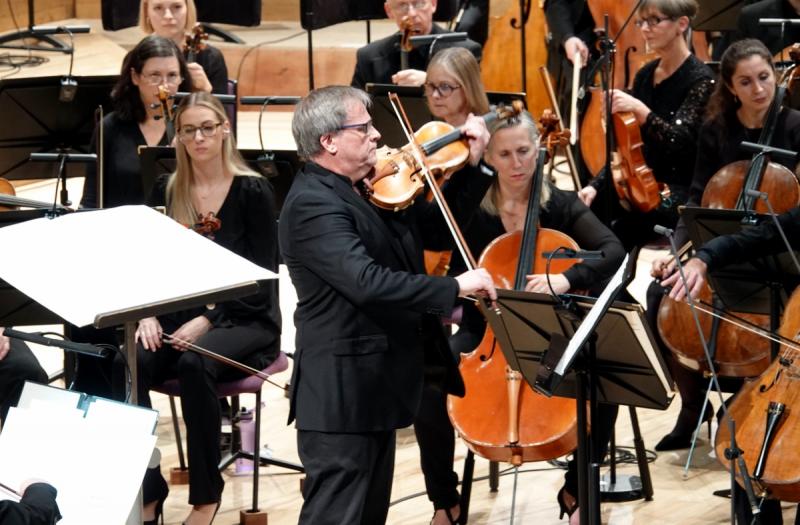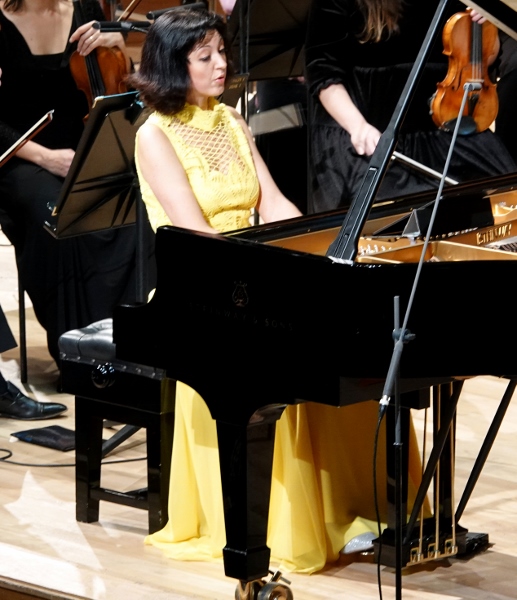Dariescu, BBC Philharmonic, Storgårds, Bridgewater Hall, Manchester review - sounds of unquenchable optimism | reviews, news & interviews
Dariescu, BBC Philharmonic, Storgårds, Bridgewater Hall, Manchester review - sounds of unquenchable optimism
Dariescu, BBC Philharmonic, Storgårds, Bridgewater Hall, Manchester review - sounds of unquenchable optimism
Conductor is his own violin soloist in one of two UK premieres

John Storgårds found himself literally facing both ways for the third item on the BBC Philharmonic’s programme on Saturday: towards the audience, with one music stand in front of him, as he played the solo violin role in Sebastian Fagerlund’s Helena’s Song, and frequently turning 180 degrees, with the full score in view, to conduct at the same time.
It was one of two BBC commissioned works (in this case co-commissioned with the Finnish Radio Symphony Orchestra) receiving their UK premieres in the concert – the other was the rather longer Shades of Unbroken Dreams by James Lee III, a piano concerto in which the soloist was Alexandra Dariescu.
If there was a golden thread running through the entire programme, I guess it was unquenchable optimism. It may be in short supply in many places right now, but music has often expressed it in the past and can do again. It began with Copland’s Fanfare for the Common Man and ended with Nielsen’s Symphony No. 4, “The Inextinguishable”.
Copland’s Fanfare launched the evening in fine style as Storgårds and his brass (and percussion) players gave three distinctly different levels of dynamic and intensity to its opening salvoes and finished on a peak of tone that should prove a good test for your equipment if you want to hear this on the radio next month.
Then there was a long pause for the rest of the orchestra to enter and tune up – perhaps needed for the ears to re-adjust. Shades of Unbroken Dreams is described as a piano concerto, and it follows the format of three movements, with the middle one tender and song-like, but there’s so much going on in the orchestra in the outer movements that at times it seems more of a concerto for orchestra with piano obbligato. It’s immensely attractive, pulling a whole range of Romantic-style levers (lovely wind and horn solos, bravura solo passages, big triumphant conclusion) and a kaleidoscope of other effects along the way: cantus firmus textures in the opening, steady, purposeful rhythms very clearly present, scurrying woodwind and strings figures, open-air bird-like sounds and horn calls, peals of bells, tambourine and sleigh bells… so you might think it needed no other justification than its own intrinsic inventiveness.
But in fact it has an explicit verbal programme, if you read the composer’s note, as well. It’s inspired by Martin Luther King’s famous “I have a dream” speech, and the composer says it’s about the idea of social justice and equality for all men and women, the first movement (subtitled “Voice Merging”) evoking a dream and seeking a future of resolution and equality, the second (“Prophetic Voice”) representing a humble plea for change, and the third (“Dynamic Spectacle”), based on the phrases "Let Freedom Ring" and "Free at Last", finishing as a climactic romp.
 Romanian-born Alexandra Dariescu (pictured left) was a gold medal winner at the Royal Northern College of Music in 2007 and it’s been a pleasure to note her starry career ever since, garnering awards, making recordings and appearing in the world’s top concert halls; she now she teaches at the RNCM, too. Her undoubted brilliance was not entirely audible in the hall (it may be different on the radio) alongside some of the orchestra writing in this piece, because it was obliterated by the noise they made, but there was evidence enough of it in the outer movements, and in the much more intimate, near-Chopinesque textures of the middle one she played its melodies with winning charm, like a ray of sunshine in a wintry world.
Romanian-born Alexandra Dariescu (pictured left) was a gold medal winner at the Royal Northern College of Music in 2007 and it’s been a pleasure to note her starry career ever since, garnering awards, making recordings and appearing in the world’s top concert halls; she now she teaches at the RNCM, too. Her undoubted brilliance was not entirely audible in the hall (it may be different on the radio) alongside some of the orchestra writing in this piece, because it was obliterated by the noise they made, but there was evidence enough of it in the outer movements, and in the much more intimate, near-Chopinesque textures of the middle one she played its melodies with winning charm, like a ray of sunshine in a wintry world.
Fagerlund’s essay for violin and orchestra is based on a scene in his opera, Stilleben, whose premiere was conducted by Storgårds, and according to the composer he jumped at the idea of making this solo piece from it. It opens with a texture of percussion, sustained strings, decorative woodwind, piano chords and timpani underlay, into which the violin creeps almost imperceptibly at first. The solo line begins to soar on its second entry, becomes increasingly animated and leads the orchestra in a crescendo before everything falls back to a unison, and then a farewell from the violin, fading down to a dying finger tremolo. It delivered, in its opening and closing, an oasis of restraint among the extroversion of so much else in the evening’s music.
Because extroversion was very much the theme of Nielsen’s “The Inextinguishable” symphony, in Storgårds’ hands. That was entirely a plus point: it’s about the force of life itself, said the composer, and the urgency and energy, both striding and strident, of the opening movement was compelling, with thrilling contrasts of dynamic and more magnificent brass playing. The sound of the wind players was completely charming in the second movement, and when it came to the strings’ turn in the slow third one, they were passionate and eloquent (Yuri Torchinsky leading).
There was a beautiful moment in the violin, viola and celli quartet (and the horn solo), before the build-up to the finale and its famous and thunderous duo for timpani. Storgårds conducted the gentler passages with sensitivity and clarity, as much as the big ones with impact and majestic effect, in one of the most impressive readings of the piece I’ve ever heard.
- Recorded for broadcast on Radio 3 on 26 January
- More classical reviews on theartsdesk
rating
Explore topics
Share this article
The future of Arts Journalism
You can stop theartsdesk.com closing!
We urgently need financing to survive. Our fundraising drive has thus far raised £49,000 but we need to reach £100,000 or we will be forced to close. Please contribute here: https://gofund.me/c3f6033d
And if you can forward this information to anyone who might assist, we’d be grateful.

Subscribe to theartsdesk.com
Thank you for continuing to read our work on theartsdesk.com. For unlimited access to every article in its entirety, including our archive of more than 15,000 pieces, we're asking for £5 per month or £40 per year. We feel it's a very good deal, and hope you do too.
To take a subscription now simply click here.
And if you're looking for that extra gift for a friend or family member, why not treat them to a theartsdesk.com gift subscription?
more Classical music
 Classical CDs: Voice flutes, flugelhorns and froth
Baroque sonatas, English orchestral music and an emotionally-charged vocal recital
Classical CDs: Voice flutes, flugelhorns and froth
Baroque sonatas, English orchestral music and an emotionally-charged vocal recital
 Kanneh-Mason, Britten Sinfonia, Shave, Milton Court - a grin and a big beaming smile
A pair of striking contemporary pieces alongside two old favourites
Kanneh-Mason, Britten Sinfonia, Shave, Milton Court - a grin and a big beaming smile
A pair of striking contemporary pieces alongside two old favourites
 theartsdesk at the New Ross Piano Festival - Finghin Collins’ musical rainbow
From revelatory Bach played with astounding maturity by a 22 year old to four-hand jazz
theartsdesk at the New Ross Piano Festival - Finghin Collins’ musical rainbow
From revelatory Bach played with astounding maturity by a 22 year old to four-hand jazz
 First Person: Manchester Camerata's Head of Artistic Planning Clara Marshall Cawley on questioning the status quo
Five days of free events with all sorts of audiences around Manchester starts tomorrow
First Person: Manchester Camerata's Head of Artistic Planning Clara Marshall Cawley on questioning the status quo
Five days of free events with all sorts of audiences around Manchester starts tomorrow
 Goldscheider, Brother Tree Sound, Kings Place review - music of hope from a young composer
Unusual combination of horn, strings and electronics makes for some intriguing listening
Goldscheider, Brother Tree Sound, Kings Place review - music of hope from a young composer
Unusual combination of horn, strings and electronics makes for some intriguing listening
 theartsdesk Q&A: composer Donghoon Shin on his new concerto for pianist Seong-Jin Cho
Classical music makes its debut at London's K-Music Festival
theartsdesk Q&A: composer Donghoon Shin on his new concerto for pianist Seong-Jin Cho
Classical music makes its debut at London's K-Music Festival
 Helleur-Simcock, Hallé, Wong, Bridgewater Hall, Manchester review - moving lyricism in Elgar’s concerto
Season opener brings lyrical beauty, crisp confidence and a proper Romantic wallow
Helleur-Simcock, Hallé, Wong, Bridgewater Hall, Manchester review - moving lyricism in Elgar’s concerto
Season opener brings lyrical beauty, crisp confidence and a proper Romantic wallow
 Kohout, Spence, Braun, Manchester Camerata, Huth, RNCM, Manchester review - joy, insight, imagination and unanimity
Celebration of the past with stars of the future at the Royal Northern College
Kohout, Spence, Braun, Manchester Camerata, Huth, RNCM, Manchester review - joy, insight, imagination and unanimity
Celebration of the past with stars of the future at the Royal Northern College
 Jansen, LSO, Pappano, Barbican review - profound and bracing emotional workouts
Great soloist, conductor and orchestra take Britten and Shostakovich to the edge
Jansen, LSO, Pappano, Barbican review - profound and bracing emotional workouts
Great soloist, conductor and orchestra take Britten and Shostakovich to the edge
 Jakub Hrůša and Friends in Concert, Royal Opera review - fleshcreep in two uneven halves
Bartók kept short, and a sprawling Dvořák choral ballad done as well as it could be
Jakub Hrůša and Friends in Concert, Royal Opera review - fleshcreep in two uneven halves
Bartók kept short, and a sprawling Dvořák choral ballad done as well as it could be

Add comment